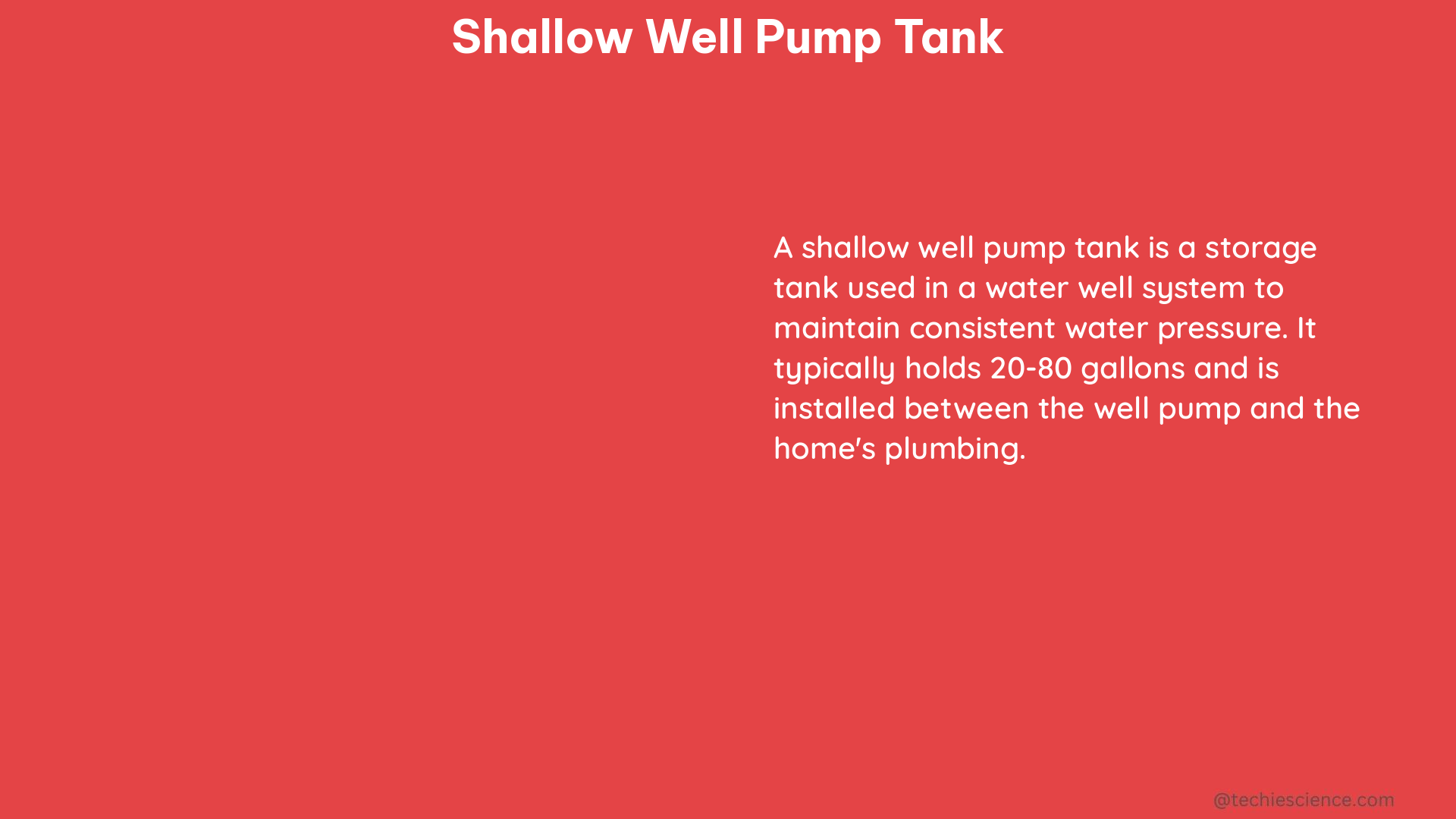A shallow well pump tank, also known as a pressure tank, is a critical component of a well water system. It stores water under pressure, allowing the pump to run less frequently and reducing wear and tear on the pump. The tank is typically filled with air at a pressure slightly below the pump’s cut-in pressure, creating a cushion of air that compresses as water is drawn out of the tank. When the pressure in the tank drops to the cut-in pressure, the pump turns on and refills the tank.
Understanding Shallow Well Pump Tank Capacity
The capacity of a shallow well pump tank is usually measured in gallons and can range from 2 to 100 gallons or more. The size of the tank needed depends on several factors:
- Pump Size: The larger the pump, the larger the tank required to accommodate the increased water flow.
- Water Demand: Households with higher water usage will require a larger tank to meet the demand.
- Pipe Length: Longer distances between the pump and the point of use will necessitate a larger tank to maintain pressure.
As a general rule, larger tanks are typically used for systems with higher water demand or longer pipe runs. For example, a 2-bedroom home with a 1/2 HP pump and a 50-foot pipe run may require a 20-gallon tank, while a 4-bedroom home with a 1 HP pump and a 100-foot pipe run may need a 50-gallon tank.
Pressure Settings for Shallow Well Pump Tanks

The pressure setting of the tank is also crucial for proper operation. The air pressure in the tank should be set 2 to 3 psi below the pump’s cut-in pressure to ensure that the pump turns on when the tank pressure drops to the desired level. This pressure setting can be adjusted using a pressure gauge and a schrader valve on the tank.
For example, if the pump’s cut-in pressure is 30 psi, the tank’s air pressure should be set to 27-28 psi. This allows the pump to turn on and refill the tank when the pressure drops to the cut-in pressure.
Materials and Construction of Shallow Well Pump Tanks
In addition to capacity and pressure settings, the material and construction of the tank are also important considerations. Shallow well pump tanks are typically made of one of the following materials:
- Steel: Steel tanks are durable and long-lasting but can be susceptible to corrosion if not properly maintained. They are available in a range of sizes, from 2 to 100 gallons or more, and can withstand pressures up to 100 psi.
- Fiberglass: Fiberglass tanks are lightweight and corrosion-resistant but may be more expensive than steel tanks. They are typically available in sizes from 20 to 80 gallons and can handle pressures up to 100 psi.
- Polyethylene: Polyethylene tanks are also corrosion-resistant and lightweight but may not be as durable as steel or fiberglass tanks. They are commonly available in sizes from 10 to 80 gallons and can withstand pressures up to 75 psi.
When selecting a shallow well pump tank, it’s essential to choose a tank that is made of high-quality materials and is designed for the specific needs of your well water system.
Factors to Consider When Choosing a Shallow Well Pump Tank
When selecting a shallow well pump tank, it’s crucial to consider the following factors:
- Well Depth: The depth of your well will determine the size of the pump and, consequently, the size of the tank required.
- Pump Size: The size of the pump (measured in horsepower) will dictate the minimum tank size needed to accommodate the water flow.
- Water Demand: Evaluate the water usage patterns in your household to determine the appropriate tank size.
- Pipe Length: The distance between the pump and the point of use will affect the tank size needed to maintain pressure.
- Material and Construction: Choose a tank made of durable, corrosion-resistant materials that are suitable for your well water system.
By carefully considering these factors, you can select a shallow well pump tank that is properly sized and designed for your specific needs, ensuring reliable and efficient operation of your well water system.
Conclusion
In summary, a shallow well pump tank is a critical component of a well water system, providing storage and pressure for the water supply. Key considerations when selecting a tank include capacity, pressure settings, material, and construction. By choosing a tank that is properly sized and designed for your specific needs, you can ensure reliable and efficient operation of your well water system.
References:
- Why is the recommended pressure for a bladder tank 2 psi less that well pump activation pressure
- Well pressure tank leaking
- Well pump problem… foot valve or bladder tank?
- PRODUCTS – Red Lion Pump

The lambdageeks.com Core SME Team is a group of experienced subject matter experts from diverse scientific and technical fields including Physics, Chemistry, Technology,Electronics & Electrical Engineering, Automotive, Mechanical Engineering. Our team collaborates to create high-quality, well-researched articles on a wide range of science and technology topics for the lambdageeks.com website.
All Our Senior SME are having more than 7 Years of experience in the respective fields . They are either Working Industry Professionals or assocaited With different Universities. Refer Our Authors Page to get to know About our Core SMEs.